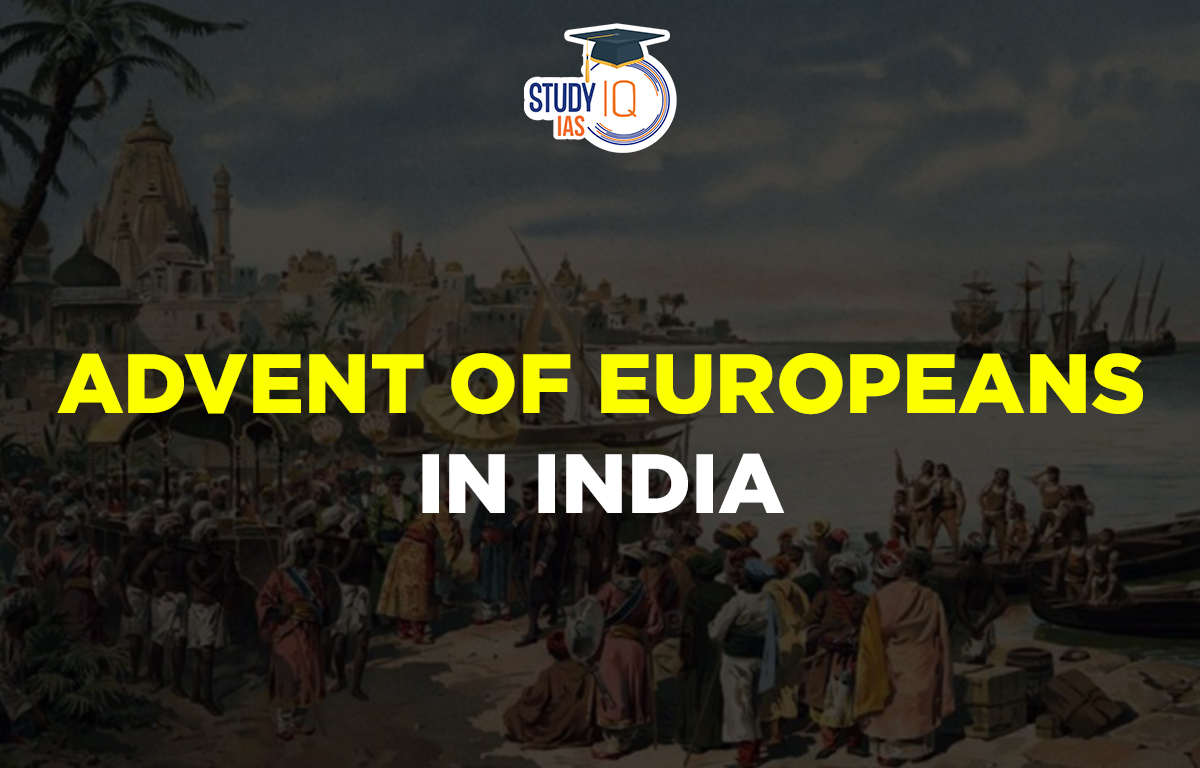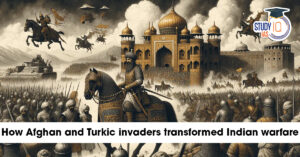Table of Contents
Advent of Europeans
The arrival of Europeans in India is considered the beginning of modern India’s history. The Oxus Valley, Syria, and Egypt were all stops along the lengthy and meandering trade routes that connected India and Europe. Following Vasco da Gama’s discovery of a new maritime route across the Cape of Good Hope in 1498, trade increased, and numerous commercial enterprises arrived in India to set up trading hubs.
All of the present European superpowers—the Dutch, English, French, Danish, and so forth gradually built economic ties with the Indian subcontinent. You will learn about the arrival of Europeans in India through this article, which will help you prepare for the UPSC Civil Service Exam.
Read about: East India Company
Advent of Europeans History
For the majority of their imports of spices and gold, the Europeans looked to India and the Indonesian Islands, where there was always a high demand and huge profit potential. Many transactions involving money eventually resulted in a small number of shady traders controlling the trade routes. Many European traders therefore had the idea to cut out the middlemen of the Middle East and Venice, deal with Turkish conflicts, and establish a direct trade route between India-East Indies (Indonesian Islands) and Europe.
Thus, in the thoughts of the Europeans, the seeds of creating industries in India were sown. Given the renaissance’s emergence and the extensive research being done in the fields of navigation and shipbuilding at the time, it was the ideal time to set out.
Delhi ceased to be a powerful centre after Aurangazeb’s passing in 1707. This made it simple for the Europeans, who had initially come for trade, to colonise and take control of the nation. During this time in history, Portugal, the Netherlands, Britain, and France all emerged as significant European nations. Britain emerged as the most powerful European who arrived in India, successfully enslaving India for 200 years.
Long before the process of colonialism began, India had a position in the European markets for trade. Indian commodities travelled over both land and marine channels in West Asia to reach European markets. The commerce was usually successful even though the merchants had to deal with obstacles along the way, such as pirates or natural disasters.
Advent of Europeans & Beginning of European settlements
Trade between Europe and South-East Asia and India was conducted during the middle Ages along a number of routes. One involved travelling by ship around the Persian Gulf, then travelling by land through Turkey and Iraq before returning by boat to Venice and Genoa. A second route went across the Red Maritime, followed by a land crossing to Alexandria, Egypt, then a subsequent sea crossing to Venice and Genoa. The Baltic Sea was the third route. It described a path that travelled overland from India’s North East Frontier to Central Asia, Russia, and the Baltic.
Arab traders and sailors dominated the trade in Asia, while Italians virtually controlled the trade in Europe and the Mediterranean. Each state imposed tolls and fees, and every business generated a significant profit. Due to the rising demand from Europeans for Asian items like spices, which command high prices in European markets, Asian trade has continued to be quite successful.
The traditional trade routes between the East and the West came under Turkish rule following the Ottoman conquest of Asia Minor and the seizure of Constantinople in 1453. The merchants of Genoa and Venice also controlled the trade between Europe and Asia and forbade the nascent nation states of Western Europe from participating in the trade along these ancient trade routes. Western European countries were looking for new sea connections to Asia as a result.
The nations and traders of West Europe desired to overthrow the Venetian and Arab trade monopolies, avoid Turkish animosity, and establish direct commercial ties with India and Indonesia. In order to find new and safer sea routes to India and the Indonesian Spice Islands, a new hunt was launched. Finding alternative routes was prioritized mostly because West Europeans valued trade with India and Indonesia too highly to give it up so easily. A further draw was India’s incredible wealth because gold was in low supply throughout Europe and was necessary as a medium of exchange.
West Europeans were well-prepared to discover new routes because throughout the 15th century, significant advancements in shipbuilding and the science of navigation had been made. Additionally, people in Western Europe had a strong sense of adventure due to the Renaissance.
Advent of Europeans in India New Routes
The items from India had to pass via various nations and hands since there was such a huge demand for these European things. Then, rulers in the Middle East and North Africa levied tolls and fees on these imported goods. Therefore, in order to enhance profits, European trading corporations tried to establish business centers there and sailed there immediately, which resulted in the advent of European businesses in India.
The items from India had to pass via various nations and hands since there was such a huge demand for these European things. Then, rulers in the Middle East and North Africa levied tolls and fees on these imported goods. Therefore, in order to enhance profits, European trading corporations tried to establish business centers there and sailed there immediately, which resulted in the advent of European businesses in India.
Additionally, after the Turks seized Constantinople in 1453, the overland route was closed. Businessmen from Venice and Genoa took control of the trade between Europe and Asia. They refused to give it to Western Europe’s emerging nation-states, especially Spain and Portugal.
Advent of European in India Chronological Order
The following timeline shows when Europeans first arrived in India as of 1498:
| Event | Year | Place |
| Arrival of the Portuguese | 1498 | Calicut, Kerala |
| Arrival of the Britishers | 1600 | Gujarat |
| Arrival of the Dutch | 1602 | Masulipatam, Andhra Pradesh |
| Arrival of the Danes | 1616 | Tamil Nadu |
| Arrival of the French | 1664 | Pondicherry |
| Commencement of Formal British | 1757 | – |
Advent of European in India UPSC
Given that it is a key event in Indian history, it is possible that a question on the UPSC topic of The Advent of Europeans in India may be asked. To make studying for the exam easier, our subject matter expert has put together the most useful notes on this topic. Candidates are recommended to read the complete document as the UPSC exam gets nearby downloading the Advent of European UPSC notes PDF.
Advent of European in India FAQs
Q) What are the causes of advent of Europeans to India?
Ans. Beginning in the early middle Ages, European traders were aware of the high demand for Indian goods including spices, calicoes, silk, various precious stones, porcelain, etc.
Q) What is the meaning of Advent of the Europeans?
Ans. The Portuguese Kingdom was able to map and discover a large portion of the world’s coastlines and marine routes to the East and West as a result of the Portuguese Empire. This sparked amazing voyages, including the one that led to the discovery of a sea passage to India via the Cape of Good Hope.
Q) When did the first Europeans come to India?
Ans. Vasco de Gama, a Portuguese explorer, arrives in Calicut on the Malabar Coast and becomes the first European to reach India via the Atlantic Ocean. In July 1497, Da Gama set sail from Lisbon, Portugal, passed the Cape of Good Hope, and stopped at Malindi on Africa’s east coast.
Q) What are the 4 causes of European exploration?
Ans. European exploration was motivated by the desire to satisfy their curiosity, pursue trade, and promote their religion, and gain political and security authority.
Q) What were the four reasons for European exploration?
Ans. Wealth & power, nationalism, religion, and the Renaissance spirit of exploration.


 Birsa Munda Birth Anniversary 2025: Life...
Birsa Munda Birth Anniversary 2025: Life...
 Military Innovations of Afghans and Turk...
Military Innovations of Afghans and Turk...
 Self-Respect Movement, History, Objectiv...
Self-Respect Movement, History, Objectiv...

























